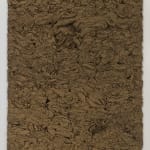Manish Nai India, b. 1980
Untitled, 2016
Natural jute
66 x 48 x 4 in
167.6 x 121.9 x 10.2 cm
Unframed
167.6 x 121.9 x 10.2 cm
Unframed
5701
Further images
This monochromatic, minimalist hanging sculpture by Manish Nai is made from a single material: dyed jute. Jute has been used in Southeast Asia, where Nai lives and works, for millennia...
This monochromatic, minimalist hanging sculpture by Manish Nai is made from a single material: dyed jute. Jute has been used in Southeast Asia, where Nai lives and works, for millennia to make rope, canvas, grain sacks, and clothes. Jute leaves are sometimes even enjoyed as a potherb in soup. During colonial times, jute’s forced cultivation enriched generations of British barons whose exploitative factories exported sacks to the cotton plantations of the American South and sandbags to the trenches of World War I. The whaling industry was also once tied to jute, as whale oil offers a perfect lubricant to prepare the fiber for machine processing. Since Nai lives and works in Mumbai, it might be tempting to interpret this work as a sort of visual synthesis of that city’s rhythmic, multi-layered environment. Yet, Nai himself has not made such a declaration. For Nai the material is more personal—his parents worked in textiles, and when their business closed, leftover jute fabric stock filled the family apartment. Compression is also an essential aspect of the work. Compression relates to time, as well as to the methodical buildup that results from repeated human gestures—an expression of both materiality and process, and a statement about the accumulating results of persistence.
Provenance
Artist Studio, MumbaiKavi Gupta, Chicago







